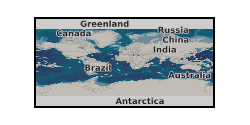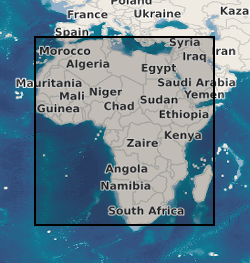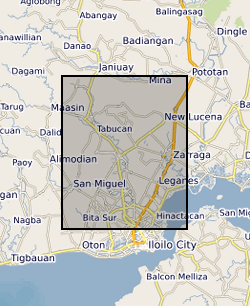Climatology
Type of resources
Available actions
Topics
Keywords
Contact for the resource
Provided by
Years
Formats
Representation types
Update frequencies
-
The International Satellite Land Surface Climatology Project (ISLSCP) has the lead role in addressing land-atmosphere interactions - process modelling, data retrieval algorithms, field experiment design and execution, and the development of global data sets. The ISLSCP II dataset contains comprehensive data over the 10 year period from 1986 to 1995, from the International Satellite Land Surface Climatology Project (ISLSCP). The ISLSCP II datasets are compiled in four key areas: land cover, hydrometeorlolgy, radiation and soils. They are mapped to consistent grids (0.5 x 0.5 degrees for topography, 1 x 1 degrees for meteorological parameters). Some data have a grid size of 0.25 x 0.25 degrees. The temporal resolution for most data sets is monthly (however a few are at finer resolution - 3 hourly). This dataset is public. ISLSCP is one of several projects of the Global Energy and Water Cycle Experiment (GEWEX), and has the lead role in addressing land-atmosphere interactions - process modelling, data retrieval algorithms, field experiment design and execution, and the development of global data sets. ISLSCP was established in 1983 under the United Nation's Environmental Programme to promote the use of satellite data for the global land surface data sets needed for climate studies. In 1994, ISLSCP produced a five-volume CD-ROM collection of global data sets to support energy, water and biogeochemical cycling studies, covering 1987 - 1988 - the ISLSCP I Initiative. The ISLSCP I data sets are available via the BADC ISLSCP I page. The ISLSCP working group meet regularly to assist Goddard Space Flight Center staff to coordinate production and publication of the various data sets in the data collection.
-
The International Satellite Land Surface Climatology Project was established in 1983 under the United Nation's Environmental Programme to promote the use of satellite data for the global land surface data sets needed for climate studies. This CD-ROM set contains the Initiative I data collection. The collection four areas : land cover, hydro-meteorology, radiation, and soils, spanning the 24 month period 1987-1988. All but one are mapped to a common spatial resolution and grid (1 degree x 1 degree). Temporal resolution for most datasets is monthly; however, a few are at a finer resolution (e.g., 6-hourly). The data within the four areas are organized into five groups within this collection: vegetation, Hydrology and Soils, Snow, Ice and Oceans, Radiation and Clouds, and Near-Surface Meteorology. This dataset collection is public. While ISLSCP Inititative I covers 2 years (1987 and 1988), ISLSCP Inititative II spans a 10-year period for 1986 to 1995.
-
The Coupled Ocean Atmosphere and European Climate (COAPEC) is a NERC thematic programme designed to examine the variability of the Earth's climate. The goal of COAPEC is to determine the impact on climate, especially European climate, of the coupling between the Atlantic Ocean and the atmosphere. The British Atmospheric Data Centre (BADC) is the primary distribution data centre for COAPEC. This dataset contains adjusted climatology data from the Southampton Oceanographic Centre (SOC).
-
The Coupled Ocean Atmosphere and European Climate (COAPEC) is a NERC thematic programme designed to examine the variability of the Earth's climate. The goal of COAPEC is to determine the impact on climate, especially European climate, of the coupling between the Atlantic Ocean and the atmosphere. The British Atmospheric Data Centre (BADC) is the primary distribution data centre for COAPEC. This dataset contains climatology data from the Southampton Oceanographic Centre (SOC).
-

Fibre-optic spectrophotometry permits the non-destructive analysis of speleothem luminescence wavelength with a temporal resolution of 1-10 years. This luminescence derives from the overlying soil organic waste matter: humification rate is climatically controlled in temperate latitudes. A pilot study demonstrates a correlation between the luminescence emission wavelength and mean annual rainfall over the last 70 years, and for the last 3000 years a remarkable 80-100 cyclicity in luminescence is observed, as well as longer term luminescence trends and the presence of short lived, severe events. This project aims to (1) provide a calibration of stalagmite luminescence over the last 100 years from sites contrasting climate, before (2) providing high resolution records of Holocene climate change from multiple samples.
-

Published papers for NERC grant NE/I020571/2. Grant award abstract: How does the Earth's climate recover from events of rapid and extreme global warming or cooling? Why have the huge fluctuations in atmospheric CO2 in the geological past not caused runaway climate effects, making the Earth become Venus- or Mars-like? Silicate weathering of the continents is the main CO2 removal process, and therefore a dominant long-term climate control mechanism. However the debate on what controls silicate weathering, and therefore atmospheric CO2, is still contentious and ongoing. A correct understanding of the controls on weathering, and its link to atmospheric CO2 levels is critical, because 1) it is possible that weathering is the process that has kept Earth's climate in the relatively narrow bounds required for life over the past several hundred million years; 2) it is impossible to decipher the causes and consequences of long-term climate variations through Earth's history without accurate weathering data, which in turn impacts on our understanding of current climate; 3) comprehension of climate systems leads to more accurate modelling of future climate change; 4) rapid global climate change inevitably leads to large mass extinctions. Therefore it is important to unravel the link between extinctions and the Earth's climate systems, including CO2 control. Lithium isotopes have gained much interest over the past few years because large variations in the Li isotope ratio in rivers and clays are caused by silicate weathering processes. Furthermore, unlike tracers of weathering used previously, Li isotopes also respond to the intensity of weathering, and therefore can be linked directly to weathering rates. This is critical, because for the first time is gives us a window into the variation of weathering rates through time, which in turn means we can use the Earth's past climate variations as a natural laboratory. Three of the largest climate fluctuations and mass extinctions in Earth's history will be examined and modelled, primarily using Li isotopes, but also several other tracers, which will serve to reveal information on marine and volcanic conditions at the time. These geological periods (the end-Ordovician glaciation (450 Ma (million years ago)), the Permo-Triassic event (251 Ma) and the Cenomanian-Turonian Ocean Anoxic Event (94 Ma)), represent times when rapid warming or cooling of Earth's climate occurred, resulting in the extinction of up to 90% of life on Earth. Samples from these time periods exist in the form of marine calcium carbonate. This was precipitated (either inorganically, or via various life forms) in the oceans at the time, and provides a record of ocean chemistry, which in turn is directly linked to the atmospheric conditions. Analysing Li isotopes is a complex procedure, and will be undertaken at Oxford University. Collaborations will exist with Prof. Jan Veizer (Ottawa University) and Dr. Christoph Korte (Copenhagen University), who are specialists in the studied time periods, with Prof. Andy Ridgwell (Bristol University), who is an expert climate modeller, and with Prof. David Harper, who is an expert in mass extinctions. By understanding weathering and climatic responses to periods of rapid global warming and cooling we will gain critical information on Earth's climate feedbacks, and on processes that led to the extinction of vast proportions of the biosphere.
-

The datasets consist of a spreadsheets containing sporomorph and biomarker data for 145 samples from Eocene sediments recovered by Integrated Ocean Drilling Programme Expedition 318. We studied palynology (pollen and dinocysts) and palaeothermometry based on Glycerol Dialkyal Glycerol Tetraethers (GDGTs) to a sedimentary record from the Wilkes Land margin, East Antarctica, recovered by the Integrated Ocean Drilling Program (IODP Expedition 318 Site U1356). These data sets provide the framework for a terrestrial climate reconstruction for the early Eocene of Antarctica. Further details of the data and their interpretation may be found in Pross et al. (2012), doi:10.1038/nature11300 and Bijl et al. (2013), PNAS, doi/10.1073/pnas.1220872110 The associated NERC grant is NE/I00646X/1 and NE/I00646X/2.
-

This dataset comprises a map of groundwater recharge for Africa and a database of the 134 observations used to generate the map. The map shows long term average annual groundwater recharge in mm per annum relevant to the period 1970 to 2020. It is in the form of a GIS shapefile and is available as a layer package for ESRI and also as a georeferenced TIFF and BIL file for easy exchange with other software. The database contains 134 sites for which ground based observations for groundwater recharge are available. These 134 sites are from previously published material and have gone through a QA procedure and been accurately geolocated to be included in the dataset. For each record there is a latitude, longitude, recharge estimate, recharge range, time period for the measurement; scale for which the estimate is made, methods used, a confidence rating and reason for this rating, and the reference from where the data originate. In addition, the database includes for each observation information from other continental datasets including: climate data, landcover, aquifer type, soil group and the normalized difference vegetation index (NDVI).
-

Middle Miocene terrestrial climate reconstructions from fossil plant remains. 197 sites are reconstructed from across the globe. These are presented with latitude-longitude co-ordinates (both modern and palaeo), published minimum and maximum ages of each site and a 1/0 column to denote those sites relating to the mid Miocene climatic optimum. Reconstructed variables are: bio1 (mean annual temperature in °C), bio8 (mean temperature of the wettest quarter in °C), bio10 (mean temperature of the warmest quarter in °C), bio11 (mean temperature of the coldest quarter in °C), bio12 (mean annual precipitation in mm), bio14 (Precipitation of Driest Month in mm), bio17 (Precipitation of Driest Quarter in mm), bio18 (Precipitation of Warmest Quarter in mm) and bio19 (Precipitation of coldest Quarter in mm). bios are presented as an optima with 0.5 and 0.95 uncertainty
-

Ensemble of simulated groundwater levels for Iloilo, Philippines. The simulated time series of data covers the period December 1979 to December 2089 under two Representative Concentration Pathways (RCP2.6 and RCP 8.5). Each ensemble member csv file contains a timeseries of groundwater levels for thirteen locations within the Iloilo region. The textfile included in the folder shows the coordinates for these locations.
 NERC Data Catalogue Service
NERC Data Catalogue Service